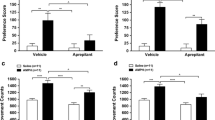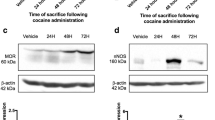Abstract
Rational
Considerable evidence suggests that the endogenous opioid system plays a role in mediating the behavioral effects of psychostimulants. Opioidergic drugs have been shown to have profound effects on cocaine-induced behavioral sensitization and conditioned reward. However, the role specifically of the mu opioid receptor in this regard is unclear as most previous pharmacological studies have used nonselective opioid receptor ligands.
Objectives
The objective of this series of experiments was to elucidate the role of mu opioid receptors in the behavioral effects of cocaine in the rat.
Materials and methods
Adult male rats were used to assess the effects of the selective mu opioid receptor antagonist d-Phe-Cys-Tyr-d-Trp-Arg-Thr-Pen-Thr (CTAP) on acute hyperactivity, locomotor sensitization, and conditioned place preference induced by cocaine. Intracerebroventricular administration of CTAP, 4 μg, was paired with peripheral injections of cocaine, 10–15 mg/kg.
Results
Mu receptor blockade significantly attenuated cocaine-induced hyperactivity, as well as the development of behavioral sensitization. Pretreatment with CTAP also prevented the development of conditioned place preference to cocaine. Administration of CTAP alone had neither effect on locomotor activity nor did it demonstrate aversive or rewarding properties.
Conclusions
These results suggest that activation of mu opioid receptors by endogenous opioids is an important contributor to cocaine-induced hyperactivity and the development of behavioral sensitization and conditioned reward.


Similar content being viewed by others
References
Akil H, Owens C, Gutstein H, Taylor L, Curran E, Watson S (1998) Endogenous opioids: overview and current issues. Drug Alcohol Depend 51(1–2):127–140
Ambrose LM, Unterwald EM, Van Bockstaele EJ (2004) Ultrastructural evidence for co-localization of dopamine D2 and mu-opioid receptors in the rat dorsolateral striatum. Anat Rec 279:583–591
Angrist B, Sathananthan G, Wilk S, Gershon S (1974) Amphetamine psychosis: behavioral and biochemical aspects. J Psychiatr Res 11:13–23
Bain GT, Kornetsky C (1987) Naloxone attenuation of the effect of cocaine on rewarding brain stimulation. Life Sci 40:1119–1125
Bartlett E, Hallin A, Chapman B, Angrist B (1997) Selective sensitization to the psychosis-inducing effects of cocaine: a possible marker for addiction relapse vulnerability. Neuropsychopharmacology 16:77–82
Bilsky EJ, Montegut MJ, Delong CL, Reid LD (1992) Opioidergic modulation of cocaine conditioned place preference. Life Sci 50:PL85–PL90
Braida D, Paladini E, Gori E, Sala M (1997) Naltrexone, naltrindole, and CTOP block cocaine-induced sensitization to seizures and death. Peptides 18(8):1189–1195
Corrigall WA, Coen KM (1991) Opiate antagonists reduce cocaine but not nicotine self-administration. Psychopharmacology (Berl) 104(2):167–170
Everitt BJ, Wolf ME (2002) Psychomotor stimulant addiction: a neuronal systems perspective. J Neurosci 22:3312–3320
Hall FS, Goeb M, Li XF, Sora I, Uhl GR (2004) Mu-opioid receptor knockout mice display reduced cocaine conditioned place preference but enhanced sensitization of cocaine-induced locomotion. Mol Brain Res 121:123–130
Hammer RP (1989) Cocaine alters opiate receptor binding in critical brain reward regions. Synapse 3(1):55–60
Heikkila RE, Orlansky H, Cohen G (1975) Studies on the distinction between uptake inhibition and release of [3H]dopamine in rat brain tissue slices. Biochem Pharmacol 24:847–852
Hitzemann RJ, Hitzemann BA, Loh HH (1974) Binding of 3H-naloxone in the mouse brain: effect of ions and tolerance development. Life Sci 14(12):2393–2404
Hollister LE, Johnson K, Boukhabza D, Gillespie HK (1981) Aversive effects of naltrexone in subjects not dependent on opiates. Drug Alcohol Depend 8:37–41
Houdi AA, Bardo MT, VanLoon GR (1989) Opioid mediation of cocaine-induced hyperactivity and reinforcement. Brain Res 497:195–198
Hummel M, Ansonoff AM, Pintar JE, Unterwald EM (2004) Genetic and pharmacological manipulation of mu opioid receptor in mice reveals a differential effect on behavioral sensitization to cocaine. Neuroscience 125:211–220
Hummel M, Schroeder JA, Liu-Chen LY, Cowan A, Unterwald EM (2006) An antisense oligodeoxynucleotide to the mu opioid receptor attenuates cocaine-induced behavioral sensitization and reward in mice. Neuroscience 142:481–491
Hurd YL, Herkenham M (1992) Influence of a single injection of cocaine, amphetamine or GBR 12909 on mRNA expression of striatal neuropeptides. Mol Brain Res 16:97–104
Izenwasser S, Heller B, Cox BM (1996) Continuous cocaine administration enhances mu- but not delta-opioid receptor-mediated inhibition of adenylyl cyclase activity in nucleus accumbens. Eur J Pharmacol 297(1–2):187–191
Kim HS, Park WK, Jang CG, Oh KW, Kong JY, Oh S, Rheu HM, Cho DH, Kang SY (1997) Blockade by naloxone of cocaine-induced hyperactivity, reverse tolerance and conditioned place preference in mice. Behav Brain Res 85:37–46
Koob GF, Le Moal M (1997) Drug abuse: hedonic homeostatic dysregulation. Science 278:52–58
Kramer TH, Shook JE, Kazmierski W, Ayres EA, Wire WS, Hruby VJ, Burke TF (1989) Novel peptidic mu opioid antagonists: pharmacologic characterization in vitro and in vivo. J Pharmacol Exp Ther 249:544–551
Lesscher HM, Hordijk M, Bondar NP, Alekseyenko OV, Burbach JP, van Ree JM, Gerrits MA (2005) Mu-opioid receptors are not involved in acute cocaine-induced locomotor activity nor in development of cocaine-induced behavioral sensitization in mice. Neuropsychopharmacology 30(2):278–285
Malcolm R, O’Neil PM, Von JM, Dickerson PC (1987) Naltrexone and dysphoria: a double-blind placebo controlled trial. Biol Psychiatry 22:710–716
Mansour A, Khachaturian H, Lewis ME, Akil H, Watson SJ (1987) Autoradiographic differentiation of mu, delta, and kappa opioid receptors in the rat forebrain and midbrain. J Neurosci 7:2445–2464
Mathon DS, Vanderschuren LJ, Ramakers GM (2006) Reduced psychostimulant effects on dopamine dynamics in the nucleus accumbens of mu-opioid receptor knockout mice. Neuroscience 141:1679–1684
Mucha RF, Millan MJ, Herz A (1985) Aversive properties of naloxone in non-dependent (naive) rats may involve blockade of central beta-endorphin. Psychopharmacology 86:281–247
Olive MF, Koenig HN, Nannini MA, Hodge CW (2001) Stimulation of endorphin neurotransmission in the nucleus accumbens by ethanol, cocaine, and amphetamine. J Neurosci 21:RC184
Pelton JT, Kazmierski W, Gulya K, Yamamura HI, Hruby VJ (1986) Design and synthesis of conformationally constrained somatostatin analogues with high potency and specificity for mu opioid receptors. J Med Chem 29(11):2370–2375
Post R, Rose H (1976) Increasing effects of receptive cocaine administration in the rat. Nature 260:731–732
Rademacher DJ, Steinpreis RE (2002) Effects of the selective mu(1)-opioid receptor antagonist, naloxonazine, on cocaine-induced conditioned place preference and locomotor behavior in rats. Neurosci Lett 332:159–162
Ritz MC, Lamb RJ, Goldberg SR, Kuhar MJ (1987) Cocaine receptors on dopamine transporters are related to self-administration of cocaine. Science 237:1219–1223
Robinson TE, Berridge KC (1993) The neural basis of drug craving: an incentive-sensitization theory of addiction. Brain Res Rev 18:247–291
Roth-Deri I, Zangen A, Aleli M, Goelman RG, Pelled G, Nakash R, Gispan-Herman I, Green T, Shaham Y, Yadid G (2003) Effect of experimenter-delivered and self-administered cocaine on extracellular beta-endorphin levels in the nucleus accumbens. J Neurochem 84(5):930–938
Sakoori K, Murphy NP (2004) Central administration of nociceptin/orphanin FQ blocks the acquisition of conditioned place preference to morphine and cocaine, but not conditioned place aversion to naloxone in mice. Psychopharmacology (Berl) 172:129–136
Schmitz JM, Stotts AL, Rhoades HM, Grabowski J (2001) Naltrexone and relapse prevention treatment for cocaine-dependent patients. Addict Behav 26(2):167–180
Schroeder JA, Niculescu M, Unterwald EM (2003) Cocaine alters mu but not delta or kappa opioid receptor-stimulated in situ [35S]GTPγS binding in rat brain. Synapse 47(1):26–32
Shippenberg TS, Bals-Kubik R (1995a) Involvement of the mesolimbic dopamine system in mediating the aversive effects of opioid antagonists in the rat. Behav Pharmacol 6:99–105
Shippenberg TS, Heidbreder C (1995b) Sensitization to the conditioned rewarding effects of cocaine: pharmacological and temporal characteristics. J Pharmacol Exp Ther 273(2):808–815
Shoblock JR, Maidment NT (2006) Constitutively active mu opioid receptors mediate the enhanced conditioned aversive effect of naloxone in morphine-dependent mice. Neuropsychopharmacology 31:171–177
Skoubis PD, Lam HA, Shoblock J, Narayanan S, Maidment NT (2005) Endogenous enkephalins, not endorphins, modulate basal hedonic state in mice. Eur J Neurosci 21(5):1379–1384
Spanagel R, Herz A, Shippenberg TS (1992) Opposing tonically active endogenous opioid systems modulate the mesolimbic dopaminergic pathway. Proc Natl Acad Sci USA 89:2046–2050
Spangler R, Unterwald EM, Kreek MJ (1993) ‘Binge’ cocaine administration induces a sustained increase of prodynorphin mRNA in rat caudate-putamen. Mol Brain Res 19(4):323–327
Steiner H, Gerfen CR (1998) Role of dynorphin and enkephalin in the regulation of striatal output pathways and behavior. Exp Brain Res 123(1–2):60–76
Suzuki T, Shiozaki Y, Masukawa Y, Misawa M, Nagase H (1992) The role of mu- and kappa-opioid receptors in cocaine-induced conditioned place preference. Jpn J Pharmacol 58:435–442
Suzuki T, Mori T, Tsuji M, Misawa M, Nagase H (1994) The role of delta-opioid receptor subtypes in cocaine- and methamphetamine-induced place preferences. Life Sci 55:339–344
Tang AH, Collins RJ (1978) Enhance analgesic effects of morphine after chronic administration of naloxone in the rat. Eur J Pharmacol 47:473–474
Unterwald EM, Rubenfeld JM, Kreek MJ (1994) Repeated cocaine administration upregulates kappa and mu, but not delta, opioid receptors. NeuroReport 5:1613–1616
Unterwald EM, Rubenfeld JM, Imai Y, Wang JB, Uhl GR, Kreek MJ (1995) Chronic opioid antagonist administration upregulates mu opioid receptor binding without altering mu opioid receptor mRNA levels. Mol Brain Res 33(2):351–355
Volterra BN, DiGiulio AM, Cuomo V, Racagni G (1984) Modulation of opioid system in C57 mice after repeated treatment with morphine and naloxone: biochemical and behavioral correlates. Life Sci 34:1669–1678
Wang D, Raehal KM, Bilsky EJ, Sadee W (2001) Inverse agonists and neutral antagonists at mu opioid receptor (MOR): possible role of basal receptor signaling in narcotic dependence. J Neurochem 77:1590–1600
White DA, Hwang ML, Holtzman SG (2005) Naltrexone-induced conditioned place aversion following a single dose of morphine in the rat. Pharmacol Biochem Behav 81(3):451–458
Yoburn BC, Nunes FA, Adler B, Pasternak GW, Inturrisi CE (1986) Pharmacodynamic supersensitivity and opioid receptor upregulation in the mouse. J Pharmacol Exp Ther 239(1):132–135
Yoo JH, Yang EM, Lee SY, Loh HH, Ho IK, Jang CG (2003) Differential effects of morphine and cocaine on locomotor activity and sensitization in mu-opioid receptor knockout mice. Neurosci Lett 344:37–40
Zubieta JK, Gorelick DA, Stauffer R, Ravert HT, Dannals RF, Frost JJ (1996) Increased mu opioid receptor binding detected by PET in cocaine-dependent men is associated with cocaine craving. Nat Med 2:1225–1229
Acknowledgments
We would like to acknowledge Mr. Alwin Forbes for his technical assistance. This work was supported by NIH/NIDA R01 DA09580 (EMU), T32 DA07237 (EMU), and Temple University.
Author information
Authors and Affiliations
Corresponding author
Rights and permissions
About this article
Cite this article
Schroeder, J.A., Hummel, M., Simpson, A.D. et al. A role for mu opioid receptors in cocaine-induced activity, sensitization, and reward in the rat. Psychopharmacology 195, 265–272 (2007). https://doi.org/10.1007/s00213-007-0883-z
Received:
Accepted:
Published:
Issue Date:
DOI: https://doi.org/10.1007/s00213-007-0883-z




